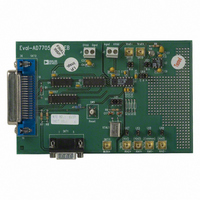EVAL-AD7706EB Analog Devices Inc, EVAL-AD7706EB Datasheet - Page 29

EVAL-AD7706EB
Manufacturer Part Number
EVAL-AD7706EB
Description
BOARD EVAL FOR AD7706
Manufacturer
Analog Devices Inc
Datasheet
1.EVAL-AD7705EB.pdf
(32 pages)
Specifications of EVAL-AD7706EB
Number Of Adc's
1
Number Of Bits
16
Sampling Rate (per Second)
500
Data Interface
Serial
Inputs Per Adc
3 Differential
Input Range
0 ~ 5.25 V
Power (typ) @ Conditions
6.5mW @ 500SPS
Voltage Supply Source
Single
Operating Temperature
-40°C ~ 85°C
Utilized Ic / Part
AD7706
Lead Free Status / RoHS Status
Contains lead / RoHS non-compliant
APPLICATIONS
The AD7705 provides a dual channel, low cost, high resolution
analog-to-digital function. Because the analog-to-digital func-
tion is provided by a sigma-delta architecture, it makes the part
more immune to noisy environments thus making the part ideal
for use in industrial and process control applications. It also
provides a programmable gain amplifier, a digital filter and
calibration options. Thus, it provides far more system level
functionality than off-the-shelf integrating ADCs without the
disadvantage of having to supply a high quality integrating ca-
pacitor. In addition, using the AD7705 in a system allows the
system designer to achieve a much higher level of resolution
because noise performance of the AD7705 is better than that of
the integrating ADCs.
The on-chip PGA allows the AD7705 to handle an analog input
voltage range as low as 10 mV full-scale with V
The differential inputs of the part allow this analog input range
to have an absolute value anywhere between GND and V
when the part is operated in unbuffered mode. It allows the user
to connect the transducer directly to the input of the AD7705.
The programmable gain front end on the AD7705 allows the
part to handle unipolar analog input ranges from 0 mV to
+20 mV to 0 V to +2.5 V and bipolar inputs of 20 mV to
bipolar ranges are with respect to a biased-up differential input.
Figure 22. Pressure Measurement Using the AD7705
Pressure Measurement
One typical application of the AD7705 is pressure measure-
ment. Figure 22 shows the AD7705 used with a pressure
transducer, the BP01 from Sensym. The pressure transducer
is arranged in a bridge network and gives a differential output
voltage between its OUT(+) and OUT(–) terminals. With rated
full-scale pressure (in this case 300 mmHg) on the transducer,
the differential output voltage is 3 mV/V of the input voltage
(i.e., the voltage between its IN(+) and IN(–) terminals).
Assuming a 5 V excitation voltage, the full-scale output range
from the transducer is 15 mV. The excitation voltage for the
bridge is also used to generate the reference voltage for the
AD7705. Therefore, variations in the excitation voltage do
not introduce errors in the system. Choosing resistor values
of 24 k and 15 k , as per Figure 22, gives a 1.92 V reference
voltage for the AD7705 when the excitation voltage is 5 V.
REV. A
OUT(–)
THERMOCOUPLE
JUNCTION
2.5 V. Because the part operates from a single supply these
EXCITATION VOLTAGE = +5V
IN+
IN–
OUT(+)
15k
24k
REF IN(+)
REF IN(–)
AIN1(+)
AIN1(–)
AIN2(+)
AIN2(–)
GND
+5V
DOUT DIN
V
AD7705
DD
CS SCLK
REF
= +1.25 V.
MCLK OUT
MCLK IN
RESET
DRDY
DD
–29–
Using the part with a programmed gain of 128 results in the
full-scale input span of the AD7705 being 15 mV, which corre-
sponds with the output span from the transducer. The second
channel on the AD7705 can be used as an auxiliary channel to
measure a secondary variable such as temperature as shown in
Figure 22. This secondary channel can be used as a means of
adjusting the output of the primary channel, thus removing
temperature effects in the system.
Figure 23. Temperature Measurement Using the AD7705
Temperature Measurement
Another application area for the AD7705 is in temperature
measurement. Figure 23 outlines a connection from a thermo-
couple to the AD7705. In this application, the AD7705 is oper-
ated in its buffered mode to allow large decoupling capacitors
on the front end to eliminate any noise pickup that may have
been in the thermocouple leads. When the AD7705 is operated
in buffered mode, it has a reduced common-mode range. In
order to place the differential voltage from the thermocouple on
a suitable common-mode voltage, the AIN1(–) input of the
AD7705 is biased up at the reference voltage, +2.5 V.
Figure 23 shows another temperature measurement application
for the AD7705. In this case, the transducer is an RTD (Re-
sistive Temperature Device), a PT100. The arrangement is a
4-lead RTD configuration. There are voltage drops across the
lead resistances R
mode voltage. There is no voltage drop across lead resistances
R
The lead resistances present a small source impedance so it
would not generally be necessary to turn on the buffer on the
AD7705. If the buffer is required, the common-mode voltage
should be set accordingly by inserting a small resistance be-
tween the bottom end of the RTD and GND of the AD7705.
In the application shown, an external 400 A current source
provides the excitation current for the PT100 and also generates
the reference voltage for the AD7705 via the 6.25 k resistor.
Variations in the excitation current do not affect the circuit as
both the input voltage and the reference voltage vary radiometri-
cally with the excitation current. However, the 6.25 k resistor
must have a low temperature coefficient to avoid errors in the
reference voltage over temperature.
THERMOCOUPLE
JUNCTION
L2
and R
REF192
GND
+5V
L3
as the input current to the AD7705 is very low
OUTPUT
L1
and R
REF IN(+)
REF IN(–)
AIN1(+)
AIN1(–)
L4
GND
but these simply shift the common-
+5V
DOUT DIN
AD7705/AD7706
V
AD7705
DD
CS
SCLK
MCLK OUT
MCLK IN
RESET
DRDY
.




















